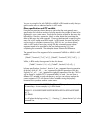
Page 20-4
You can try using this list with TMENU or MENU in RPN mode to verify that you
get the same menu as obtained earlier in ALG mode.
Menu specification and CST variable
From the two exercises shown above we notice that the most general menu
specification list include a number of sub-lists equal to the number of items to be
displayed in your custom menu. Each sub-list contains a label for the menu key
followed by a function, expression, label, or other object that constitutes the
effect of the menu key when pressed. Care must be exercised in specifying the
menu list in ALG mode versus RPN mode. In RPN mode, the menu key action
can be simply a calculator command (e.g., EXP, LN, etc., as shown above),
while in ALG mode it has to be a string with the command prompt whose
argument needs to be provided by the user before pressing ` and
completing the command. The examples above illustrate the difference.
The general form of the argument list for commands TMENU or MENU in ALG
mode is
{“label1”,”function1(“,”ls1(“,”rs1(“}, {“label2”, “function2(“,”ls2(“,”rs2(“},…}
While, in RPN mode, the argument list has this format
{“label1”, function1, ls1, rs1}, {“label2”, function2, ls2, rs2},…}
In these specifications, function1, function 2, etc., represent the main operation
of the key, while ls1, ls2, …, etc., represent the left-shift operation of the key.
Similarly, rs1, rs2, …, etc., represent the right-shift operation of the key. This list
will be stored in variable CST if command MENU is used. You can have a
different CST variable in each sub-directory, and you can always replace the
current contents of CST with those of other variables storing the properly
formatted list to produce another custom menu.
Note: You can use a 21x8 GROB (See Chapter 22) to produce an icon in the
soft menu keys. As an example, try, in RPN mode:
{{GROB 21 8 00000EF908FFF900FFF9B3FFF9A2FFF9A3FFF9A0FFF388FF
“hp” }}
` MENU
This will place the hp logo on key
A. Pressing A places the text ‘hp’ in the
command line.


















